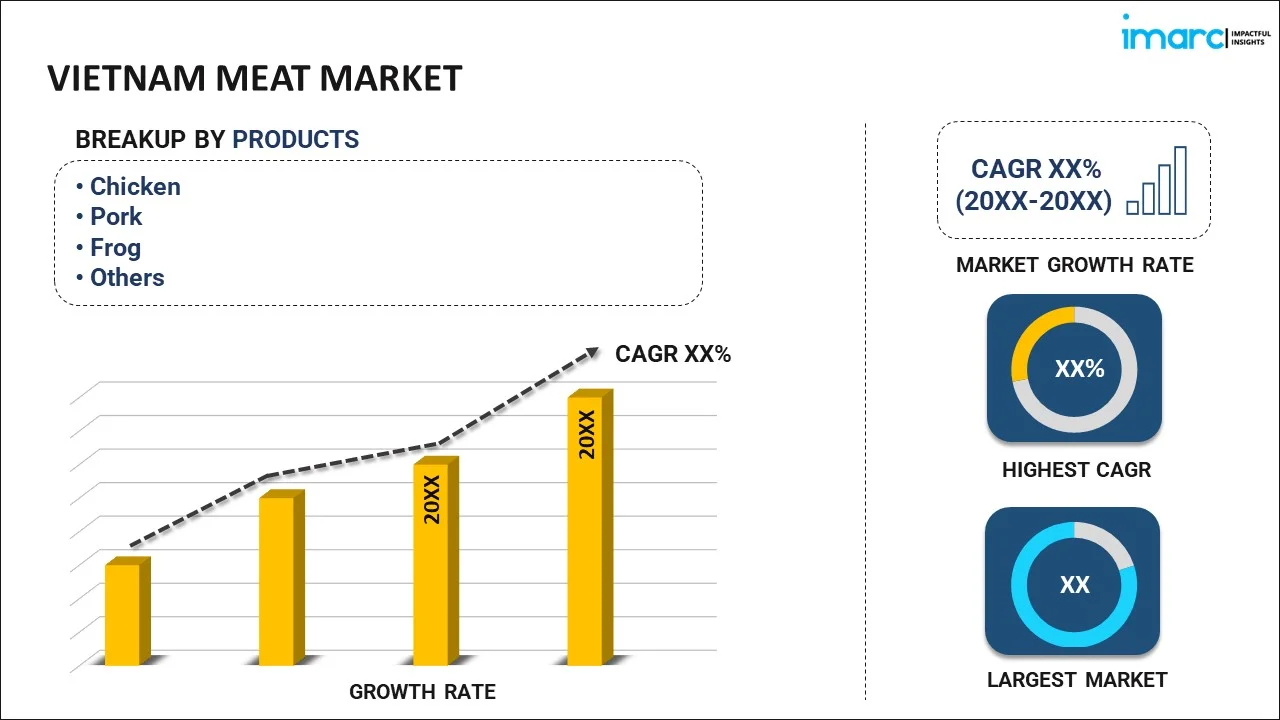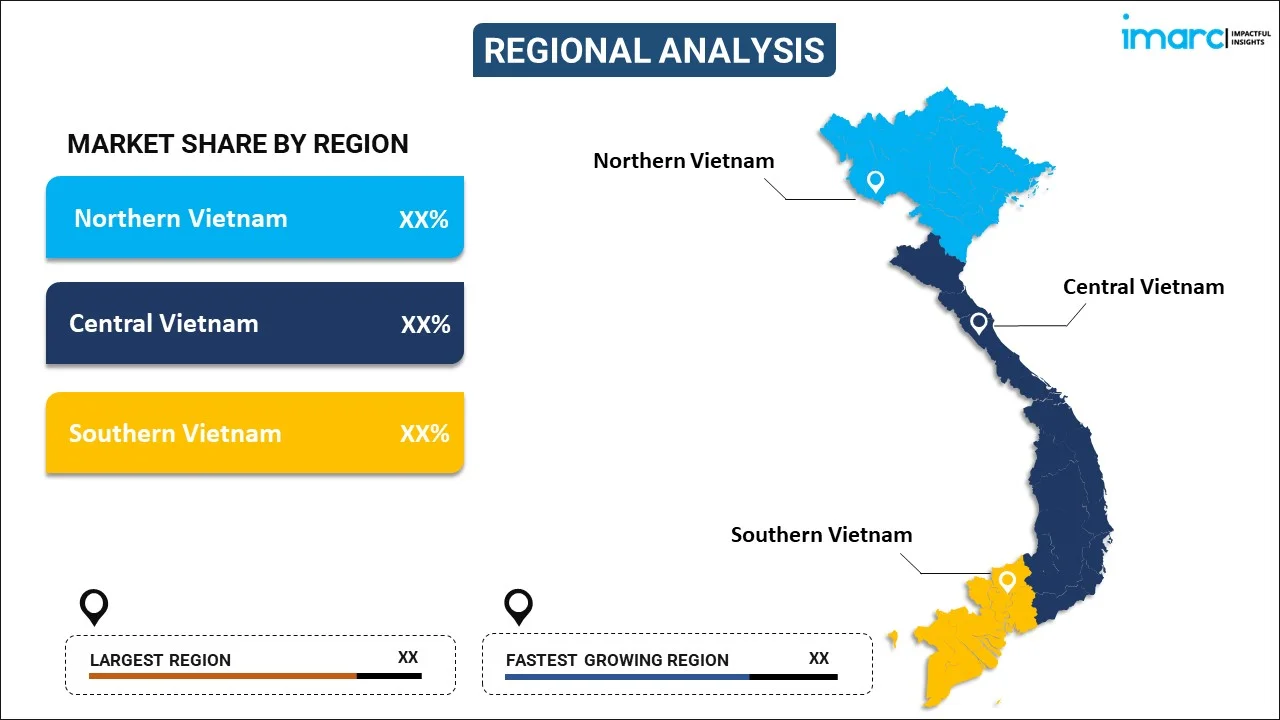
Vietnam Meat Market Report by Product (Chicken, Pork, Frog, Duck, Mutton), Type (Raw, Processed), Distribution Channel (Departmental Stores, Specialty Stores, Hypermarket/ Supermarket, Online Sales Channel, and Others), and Region 2025-2033
Market Overview:
Vietnam meat market size reached USD 5.7 Billion in 2024. Looking forward, IMARC Group expects the market to reach USD 8.7 Billion by 2033, exhibiting a growth rate (CAGR) of 4.78% during 2025-2033. The increasing income levels, rapid urbanization, changing dietary preferences, rapid economic growth in the foodservice industry, increasing global trade agreements, and rising health and nutrition awareness represent some of the key factors driving the market.
|
Report Attribute
|
Key Statistics
|
|---|---|
|
Base Year
|
2024
|
|
Forecast Years
|
2025-2033
|
|
Historical Years
|
2019-2024
|
|
Market Size in 2024
|
USD 5.7 Billion |
|
Market Forecast in 2033
|
USD 8.7 Billion |
| Market Growth Rate 2025-2033 | 4.78% |
Meat is the flesh of animals that is consumed as food by humans. It is a primary source of protein in many diets around the world and comes in various forms, including beef, pork, poultry, and lamb. The production of meat involves the slaughtering and processing of animals, typically livestock, to obtain their muscle tissues. These tissues are then prepared and cooked in various ways to create a wide variety of dishes. Meat is a rich source of essential nutrients, including proteins, vitamins, and minerals, making it an essential component of balanced diets. Proteins found in meat are known for their role in muscle growth, tissue repair, and overall bodily functions. Additionally, meat provides essential vitamins like B12 and minerals such as iron and zinc, which are vital for maintaining good health.
Vietnam Meat Market Trends:
Growth in Domestic Meat Processing Capacity
Vietnam's meat processing sector has seen steady investment from both local and foreign companies aiming to boost supply chain efficiency and product safety. Traditional wet markets are still common, but there's a gradual shift toward packaged meat sold in supermarkets and convenience stores. This change is partly driven by consumer preference for hygiene and consistent quality, as well as stricter government regulations on food safety. New facilities with modern equipment are increasing the output of processed meats like sausages, cold cuts, and marinated cuts tailored for urban households. The Vietnam processed meat market is also benefiting from the rise of large-scale farming, which provides a more standardized and traceable source of meat, further strengthening the industrial backbone of the sector.
Shifting Consumer Preferences across Meat Types
Vietnamese consumers are diversifying their meat choices beyond pork, which has long dominated the market. Poultry and beef consumption are rising steadily, while newer options like duck, goat, and imported meats are carving out niche demand. Health-conscious buyers are influencing this shift, opting for leaner proteins and trying different cuts or cooking styles. Western influence through media and tourism has introduced what types of food are popular globally, helping expand awareness and interest in other types of meat. Retailers are responding by offering more variety in both traditional and modern retail formats. This broadening demand is pushing producers to adapt sourcing, processing, and packaging to cater to a wider set of expectations across the Vietnamese meat market.
Surge in Demand from Quick-Service and Food Delivery Channels
Meat demand in Vietnam is increasingly shaped by the fast-growing quick-service restaurant sector and online food delivery platforms. Urban consumers, especially younger demographics, are ordering more prepared meals, pushing restaurants and cloud kitchens to stock reliable and consistent meat supplies. Fried chicken, burgers, grilled skewers, and meat-based rice dishes are among the top sellers across delivery apps. This shift creates opportunities for meat suppliers to partner directly with foodservice brands, offering portioned, semi-cooked, or frozen products tailored for fast turnaround. The demand for speed, convenience, and quality is putting pressure on processors like Viet meat to innovate in packaging and storage, ensuring freshness without sacrificing safety or taste.
Urban Lifestyles Reshaping Eating Habits
Rural-to-urban migration and rising income levels are changing how people in Vietnam eat. In cities like Ho Chi Minh City and Hanoi, smaller households and busy schedules have led to greater reliance on ready-to-cook and ready-to-eat meat products. Traditional home-cooked meals are becoming less frequent during the week, replaced by convenience meals or eating out. Supermarkets and minimarts now carry a wide range of packaged meat options that cater to these habits. Refrigeration access, once limited, is now more common in urban homes, supporting bulk purchases and frozen storage. This urban consumer base is also more brand-aware and willing to pay a premium for trusted labels, including premium options like Vietnam black chicken, which has gained attention for its perceived health benefits and unique flavor.
Vietnam Meat Market Segmentation:
IMARC Group provides an analysis of the key trends in each segment of the market, along with forecasts at the country level for 2025-2033. Our report has categorized the market based on product, type, and distribution channel.
Product Insights:

To get more information on this market, Request Sample
- Chicken
- Pork
- Frog
- Duck
- Mutton
The report has provided a detailed breakup and analysis of the market based on the product. This includes chicken, pork, frog, duck, and mutton.
Type Insights:
- Raw
- Processed
A detailed breakup and analysis of the market based on the type have also been provided in the report. This includes raw and processed.
Distribution Channel Insights:
- Departmental Stores
- Specialty Stores
- Hypermarket/ Supermarket
- Online Sales Channel
- Others
The report has provided a detailed breakup and analysis of the market based on the distribution channel. This includes departmental stores, specialty stores, hypermarket/ supermarket, online sales channel, and others.
Regional Insights:

- Northern Vietnam
- Central Vietnam
- Southern Vietnam
The report has also provided a comprehensive analysis of all the major regional markets, which include Northern Vietnam, Central Vietnam, and Southern Vietnam.
Competitive Landscape:
The market research report has also provided a comprehensive analysis of the competitive landscape in the market. Competitive analysis such as market structure, key player positioning, top winning strategies, competitive dashboard, and company evaluation quadrant has been covered in the report. Also, detailed profiles of all major companies have been provided.
Vietnam Meat Market News:
- In July 2025, JBS shipped 27 tons of beef to Vietnam from its Mozarlândia plant in Brazil, marking its first export to the country. Both the Mozarlândia and Goiânia facilities were recently approved to supply the Vietnamese market. JBS views this entry as a strategic step in expanding across Asia, aiming to meet rising demand for animal protein in the region while positioning itself in a high-growth export market.
- In March 2025, Brazil’s JBS announced plans to invest USD100 Million to build two meat-processing plants in Vietnam. The facilities would produce beef, pork, and poultry using Brazilian raw materials, targeting both the Vietnamese market and neighboring Southeast Asian countries. The agreement signals a major step in opening Vietnam’s meat market to Brazilian exports. JBS aims to strengthen its regional presence through this expansion.
- In December 2024, Sojitz Corporation launched operations at one of Vietnam’s largest beef processing plants in Tam Dao, Vinh Phuc Province, through its group firm Japan Vietnam Livestock Co., Ltd. The facility is Vietnam’s first to process refrigerated beef in a strictly sanitized environment. Sojitz plans to scale up production to around 10,000 tons of beef annually for domestic supply and future market growth.
Vietnam Meat Market Report Coverage:
| Report Features | Details |
|---|---|
| Base Year of the Analysis | 2024 |
| Historical Period | 2019-2024 |
| Forecast Period | 2025-2033 |
| Units | Billion USD |
| Scope of the Report | Exploration of Historical and Forecast Trends, Industry Catalysts and Challenges, Segment-Wise Historical and Predictive Market Assessment:
|
| Products Covered | Chicken, Pork, Frog, Duck, Mutton |
| Types Covered | Raw, Processed |
| Distribution Channels Covered | Departmental Stores, Specialty Stores, Hypermarket/ Supermarket, Online Sales Channel, Others |
| Regions Covered | Northern Vietnam, Central Vietnam, Southern Vietnam |
| Customization Scope | 10% Free Customization |
| Post-Sale Analyst Support | 10-12 Weeks |
| Delivery Format | PDF and Excel through Email (We can also provide the editable version of the report in PPT/Word format on special request) |
Key Benefits for Stakeholders:
- IMARC’s industry report offers a comprehensive quantitative analysis of various market segments, historical and current market trends, market forecasts, and dynamics of the Vietnam meat market from 2019-2033.
- The research report provides the latest information on the market drivers, challenges, and opportunities in the Vietnam meat market.
- Porter's five forces analysis assist stakeholders in assessing the impact of new entrants, competitive rivalry, supplier power, buyer power, and the threat of substitution. It helps stakeholders to analyze the level of competition within the Vietnam meat industry and its attractiveness.
- Competitive landscape allows stakeholders to understand their competitive environment and provides an insight into the current positions of key players in the market.
Key Questions Answered in This Report
The meat market in Vietnam reached USD 5.7 Billion in 2024.
The Vietnam meat market is projected to exhibit a CAGR of 4.78% during 2025-2033, reaching USD 8.7 Billion by 2033.
Rising incomes, rapid urbanization, and changing diets are increasing meat consumption in Vietnam. Growth is strongest in pork and poultry, supported by modern retail expansion, domestic production scaling, and food safety concerns that favor branded meat. Government support and foreign investment are also boosting processing and cold chain infrastructure.
Need more help?
- Speak to our experienced analysts for insights on the current market scenarios.
- Include additional segments and countries to customize the report as per your requirement.
- Gain an unparalleled competitive advantage in your domain by understanding how to utilize the report and positively impacting your operations and revenue.
- For further assistance, please connect with our analysts.
 Request Customization
Request Customization
 Speak to an Analyst
Speak to an Analyst
 Request Brochure
Request Brochure
 Inquire Before Buying
Inquire Before Buying




.webp)




.webp)












